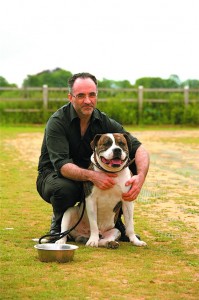In March, Roly, an eight-year-old male American bulldog, underwent successful surgery at Fitzpatrick Referrals, a specialist veterinary clinic in Surrey, UK, following diagnosis that he was suffering from cancer in his rear hind leg. Nine weeks after the procedure, Roly is able to walk again, thanks to the insertion of a unique metal implant that mirrors the original femur and boasts a tendon in-growth attachment.
The clinical procedure carried out by Noel Fitzpatrick and team replaced the cancerous femur bone and hip joint with a specially constructed artificial prosthesis, while re-attaching the musculature and realigning the relative position of the joint. The prosthesis was designed over three years by collaboration between Fitzpatrick, Gordon Blunn of UCL and Jay Meswania from specialist implant manufacturer OrthoFitz.
“What is significant about the design is the way it sandwiches tissue and metal together overlaying the gluteal muscles onto the top of the endoprosthetic femur – alternatingtendon, synthetic Dacron mesh, tendon, synthetic Dacron mesh, tendon and finally trabecular metal – which has a honeycomb surface resembling a series of small chambers. In this way, the hope is that the Sharpeys fibres will grow into the trabecular metal surface and permanently adhere to it,” Blunn said.
“This achievement was made possible through the convergence of biomechanics, biology and surgical innovation,” Fitzpatrick said.
“Data collected about Roly during clinical diagnosis was used to design and construct an artificial femur which exactly mirrored his original limb.”
“Hip replacement is common here. We do more than 50 a year, on animals as small as a cat or a Chihuahua. But this hip replacement was special, and to my knowledge, the first of its kind in the world. It’s important though to emphasise that this technology must only be employed when it is in the best interests of the patient. It must be ethically right,” he said.
Fitzpatrick believes that medical and veterinary science are closely linked, and improvements in one area impacts the other. It is thought that Roly’s experience has potentially life-changing implications for humans, particularly accident victims. In motorcycle incidents, a key challenge is re-attaching the kneecap tendon to the top of the tibia in the lower leg. Similarly, the technology could prove meaningful in the repair of ruptured shoulder tendons of cricketers or tennis players.




